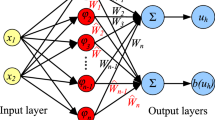Abstract
To enhance the generalization performance of radial basis function (RBF) neural networks, an RBF neural network based on a q-Gaussian function is proposed. A q-Gaussian function is chosen as the radial basis function of the RBF neural network, and a particle swarm optimization algorithm is employed to select the parameters of the network. The non-extensive entropic index q is encoded in the particle and adjusted adaptively in the evolutionary process of population. Simulation results of the function approximation indicate that an RBF neural network based on q-Gaussian function achieves the best generalization performance.
Similar content being viewed by others
References
Moody J, Darken C. Fast learning in networks of locally-tuned processing units. Neural Computation, 1989, 1(2): 281–294
Kong L X, Xiao D M, Liu Y L. Rough set and radial basis function neural network based insulation data mining fault diagnosis for power transformer. Journal of Harbin Institute of Technology (New Series), 2007, 14(2): 263–268
Feng Y, Wu Z F, Zhong J, Ye C X, Wu K Q. An enhanced swarm intelligence clustering-based RBFNN classifier and its application in deep sources classification. Frontiers of Computer Science in China, 2010, 4(4): 560–570
Wan L H, Zhang S H, Liu W Y, Zang S Y. ARBF classification method of remote sensing image based on genetic algorithm. Journal of Harbin Institute of Technology (New Series), 2006, 13 (6): 711–714
Karayiannis N B, Randolph-Gips M M. On the construction and training of reformulated radial basis function neural networks. IEEE Transactions on Neural Networks, 2003, 14(4): 835–846
Karayiannis N B, Xiong Y H. Training Reformulated radial basis function neural networks capable of identifying uncertainty in data classification. IEEE Transactions on Neural Networks, 2006, 17(5): 1222–1234
Gholizadeh S, Salajegheh E, Torkzadeh P. Structural optimization with frequency constraints by genetic algorithm using wavelet radial basis function neural network. Journal of Sound and Vibration, 2008, 312(1–2): 316–331
De Silva C R, Ranganath S, De Silva L C. Cloud basis function neural network: A modified RBF network architecture for holistic facial expression recognition. Pattern Recognition, 2008, 41(4): 1241–1253
Harpham C, Dawson C W. The effect of different basis functions on a radial basis function network for time series prediction: A comparative study. Neurocomputing, 2006, 29(16–18): 161–170
Billings S A, Wei H L, Balikhin MA. Generalized multiscale radial basis function networks. Neural Networks, 2007, 20(10): 1081–1094
Thistleton W, Marsh J A, Nelson K, Tasllis C. Generalized Box-Müller method for generating q-Gaussian random deviates. IEEE Transactions on Information Theory, 2007, 53(12): 4805–4810
Wang Y, Cai Z X. A hybrid multi-swarm particle swarm optimization to solve constrained optimization problems. Frontiers of Computer Science in China, 2009, 3(1): 38–52
Shi Y H, Eberhart R. Monitoring of particle swarm optimization. Frontiers of Computer Science in China, 2009, 3(1): 31–37
Author information
Authors and Affiliations
Corresponding author
Additional information
Wei Zhao received his Masters degree from Harbin Engineering University in 2007. He is a PhD candidate at the Harbin Institute of Technology, China. His research interests include quantum genetic algorithms, quantum-behaved particle swarm algorithms, and neural networks.
Ye San is a professor and PhD advisor at the Harbin Institute of Technology. He received his bachelor degree from Harbin Institute of Technology, China, in 1976. His research interests include modeling, simulation and optimization of complex systems.
Rights and permissions
About this article
Cite this article
Zhao, W., San, Y. RBF neural network based on q-Gaussian function in function approximation. Front. Comput. Sci. China 5, 381–386 (2011). https://doi.org/10.1007/s11704-011-1041-7
Received:
Accepted:
Published:
Issue Date:
DOI: https://doi.org/10.1007/s11704-011-1041-7




